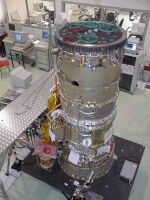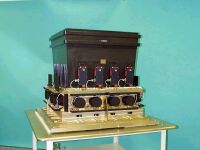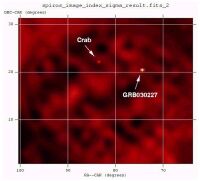Summary
The mission is dedicated to the fine spectroscopy (E/∆E = 500) and fine imaging (angular resolution: 12 arcmin FWHM) of celestial gamma-ray sources in the energy range 15 keV to 10 MeV with concurrent source monitoring in the X-ray (4-35 keV) and optical (V-band, 550 nm) energy ranges.
Gamma-rays are even more powerful than the X-rays used in medical examinations. Fortunately, the Earth's atmosphere acts as a shield to protect us from this dangerous cosmic radiation. However, this means that gamma-rays from astronomical sources can only be detected by satellites. INTEGRAL is the most sensitive gamma-ray observatory ever launched.
INTEGRAL is a truly international mission with the participation of all member states of ESA plus the United States, Russia, Czech Republic, and Poland. ESA appointed Alenia Spazio, Italy, as industrial prime contractor, responsible for the design, integration and testing of the satellite. On board, four instruments from teams led by scientists in Italy, France, Germany, Denmark, and Spain are today gathering and analysing the gamma-rays from space. A Russian Proton rocket successfully placed the spacecraft into orbit. ESA and NASA ground stations are keeping in touch with INTEGRAL. The mission operations centre responsible for satellite control is located at ESOC in Germany. The INTEGRAL Science Operations Centre (ISOC) at Noordwijk, the Netherlands, is providing the observation plan, and Switzerland hosts the centre for the scientific data, the INTEGRAL Science Data Centre (ISDC).
The Orbit
Every three days INTEGRAL orbits the Earth once. The spacecraft spends most of its time at the furthest parts of its orbit, at an altitude higher than 40 000 kilometres, well outside the Earth's radiation belts, to avoid background radiation effects. From here ESA's gamma-ray observatory sends back to Earth new information about the most exciting phenomena in the universe. It reports on violent explosions, the formation of elements, black holes and other exotic objects in our Milky Way, the cosmic neighbourhood and much further, in distant galaxies at the edge of the observable universe.
The Spacecraft
Standing 5 metres high and more than 4 tonnes in weight, the INTEGRAL spacecraft is impressive. The satellite has two main parts:
-
The service module is the lower part of the satellite and contains all spacecraft subsystems
-
The payload module is mounted on the service module and carries the scientific instruments.
 |
|
SPI Instrument |
To limit the costs of the mission the service module is a rebuild of the one developed for XMM-Newton, ESA's X-ray Multi-Mirror satellite. It is a closed structure made of composite material, a combination of aluminium and carbon fibre. It houses the satellite systems, including solar power generation, power conditioning and control, data handling, telecommunications and thermal, attitude and orbit control.
The four scientific instruments of INTEGRAL's payload module weigh 2 tonnes, making this payload the heaviest ever placed in orbit by ESA. This is due to the need to shield the detectors from background radiation in order to make them sensitive. There are two main instruments detecting gamma-rays. The imager gives the sharpest gamma-ray images yet seen from astronomical targets. Meanwhile the spectrometer precisely measures gamma-ray energies. Two other instruments, an X-ray monitor and an optical camera, help to identify the gamma-ray sources.
 |
|
IBIS Instrument |
What are we made of?
Today's science has found an answer to this age-old question: Most of the elements in our bodies and in everything around us come from dead stars! But how can new elements be formed when a star dies? To answer this question precisely, more basic research has to be done. INTEGRAL helps us to find out more about this element-making process.
It sounds paradoxical: the events that made the universe habitable were catastrophic. Violent stellar explosions provided the energy that was needed to form the elements from which planets and living things could be built. Gamma-rays from these supernova explosions and from newly formed radioactive elements are registered by INTEGRAL.
Gamma-rays also appear after a supernova explosion when matter squirms in the intense gravity of the collapsed and very dense star remnant. Studying such compact objects as neutron stars or black holes is a second, very important, task of INTEGRAL.
|
SPI Image of a Gamma-Ray Burst |
Even stranger than the energetic radiation coming from the centre of distant galaxies are the flashes of extremely powerful radiation that suddenly appear somewhere in the gamma sky and disappear again after a short time. Observations in different wavelengths confirm that these bursts are the biggest observed explosions in the Universe. However, what is it that is exploding out there? This is another cosmic mystery that INTEGRAL is helping to solve.

